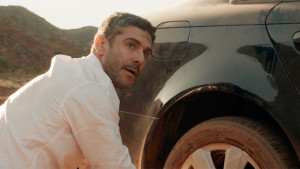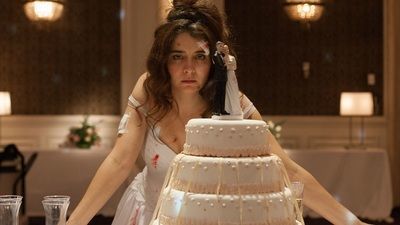By William Repass.
Newton’s Third Law does not hold sway in Argentine filmmaker Damián Szifron’s Wild Tales (Relatos salvajes, 2014). On the contrary, action leads only to overreaction, effect revenging itself on cause. Each of the six thematically interlocking shorts that comprise the film advances by means of escalation. In “Pasternak”, the eponymous pilot, a failed composer, steers an airliner full of his old grudges into a quiet suburb. In “Las ratas” (“The Rats”), a waiter and cook debate whether or not to poison the loan shark cum politician responsible for destroying the waiter’s family. “El más fuerte” (“The Strongest”) opens with a lewd gesture between drivers and closes with an explosion. “Bombita” (“Little Bomb”) follows a demolitionist who repays a series of towing tickets with a car-bomb. In “La propuesta” (“The Proposal”), a teenager hits a pregnant woman with his father’s car; his father, buying off lawyers left and right, strikes a deal with the gardener to take the charge. “Hasta que la muerte nos separe” (“Until Death Do Us Part”) sees a marriage ceremony spectacularly implode, only to resolve, for a moment at least, when bride and groom obliterate the many-tiered wedding cake with their frenzied coupling. Taken together, these narratives of escalation—which escalate themselves, from less to more intimate relations between revenging parties—form a bleak portrait of class-ridden Argentine society, exposing the inhumanity of human nature.
 Szifron allows this critique to arise concretely, through a chain of motifs cutting across the whole anthology. Color pairings feature prominently, always working in opposition. The first character to appear on screen, doomed to a grisly end for cheating on Pasternak, wears a white suit with black trimming. Likewise, the floor of the restaurant in “Las ratas” is a composite of black and white tile-fragments. By“El más fuerte”, color clearly begins to highlight class-conflict. The patrician driver wears a black-and-white suit, while his working-class adversary wears a bruised-looking blue-and-red plaid—soon to be matched by his blood-spattered face. “Bombita” sets the bright yellows of no-parking zones against the muted blues of the tow company’s livery. “La propuesta” restricts itself to banknote shades. “Hasta que la muerte” returns to a black-and-white dominated mise-en-scene, the bride’s white dress contrasted by a black one, worn by a woman the groom has cheated with— contrasted in turn by the white uniform of a cook the bride subsequently cheats with, by way of revenge, and culminating in the ambiguous final shot, with its plastic bride-and-groom cake-topper, fallen among what remains of its former perch.
Szifron allows this critique to arise concretely, through a chain of motifs cutting across the whole anthology. Color pairings feature prominently, always working in opposition. The first character to appear on screen, doomed to a grisly end for cheating on Pasternak, wears a white suit with black trimming. Likewise, the floor of the restaurant in “Las ratas” is a composite of black and white tile-fragments. By“El más fuerte”, color clearly begins to highlight class-conflict. The patrician driver wears a black-and-white suit, while his working-class adversary wears a bruised-looking blue-and-red plaid—soon to be matched by his blood-spattered face. “Bombita” sets the bright yellows of no-parking zones against the muted blues of the tow company’s livery. “La propuesta” restricts itself to banknote shades. “Hasta que la muerte” returns to a black-and-white dominated mise-en-scene, the bride’s white dress contrasted by a black one, worn by a woman the groom has cheated with— contrasted in turn by the white uniform of a cook the bride subsequently cheats with, by way of revenge, and culminating in the ambiguous final shot, with its plastic bride-and-groom cake-topper, fallen among what remains of its former perch.
As implied by the title, animals play a crucial (if oblique) role in Wild Tales—metaphors for a vestigial wildness pervading our civilized societies. Pasternak’s ex flips absent-mindedly through an in-flight magazine, pausing on a photograph of several cheetahs fast on the heels of a baby gazelle. Cheetahs make a second appearance in the opening credits, which mutate the Kuleshov Effect by captioning a series of strikingly life-like yet still images of predators and prey, with the names of the film-crew. An eagle, a shark, a lion; a sheep, a giraffe, a zebra: subjected our naming compulsion, each takes on a human identity—animalizing it in the process[1]. In the film proper, we never see a live animal in motion. Nevertheless, animal-spirits possess the characters; references to animals infest the dialogue and mise-en scene. In the father’s lavish house of “La propuesta”, for example, a pair of shark skulls punctuate the hodgepodge of primitive and modern art. Together, these foreshadow the father’s predatory instincts, even as they gesture back to the shark in the opening credits. Not to mention the loan shark in “Las ratas”, whom the cook debilitates with expired rat-poison. In “Bombita”, Szifron’s camera shoots up through a sewer-grate to capture the demolitionist, staring in disbelief at the towing notice pasted across its bars—as if to imply that we, the spectators, are rats also. But, sideways of moments like these, it’s the preponderance of vehicles in Wild Tales which, repeatedly—paradoxically—evoke the animal kingdom. Sleek and lethal, automobiles owned by the film’s upper-crustier characters recall cheetahs, lions, jaguars. The jet in “Pasternak”, echoed by navigation lights strobing through the night-sky in “Hasta que la muerte”; the model ships in “La propuesta”, gesturing toward Argentina’s ongoing history of colonialism and wholesale plunder; the towtrucks in “Bombita”—all serve as, or represent, vehicles for revenge: extensions of raw power. The animalistic blurs into the mechanistic, as if skipping over what (if anything) is human, and Szifron appears to presuppose the unconscious repetition of violence and exploitation. Compare Wild Tales with the classic wildlife documentary, overstuffed with life-and-death struggles. Pipe in a little Attenborough voiceover, and the resemblances would crystallize.
 Cakes, as we’ve begun to see already, form another symbolic resonance within the film. They make only three concrete appearances (yet embody Wild Tales‘ master-conceit). First, in “Bombita”, as a gift—the acquisition of which gets the demolitionist’s car towed, sparking off the next chain of revenges that will drive the narrative forward. Second, as a reciprocal gift, book-ending the same short. And third, in “Hasta que la muerte,” as a manifestation of the alliance between two wealthy families. Cake #1 is topped with candles, foreshadowing the car-bomb’s controlled destruction. Cake #2 features an anthropomorphic towtruck, standing in for the mechanization our demolitionist tries to combat. Cake #3 stages the aforementioned bride-and-groom. Exchangeable, consumable, structural, layered (each flavor playing-off its neighbors), these baked-goods may be read as a likeness of the societal form Szifron endeavors to critique. Only after the groom wolfs down a slice of cake, does sexual reconciliation between bride and groom (between their families), emerge as a possibility. As such, it is difficult to read the film’s ending in a hopeful light. The rapprochement between ruling-class families only sediments the revenge/counter-revenge, victor/victim relations all the way down the food-chain, as it were, of class-society. Nor is it possible to predict a happy marriage. Szifron shows us no exit from this Samsara of cause-and-effect. In “El más fuerte,” the mirror-short to “Hasta que la muerte,” cake is prefigured in the volcanic, sedimentary crags that background the action. After the struggle for supremacy between working and upper-class drivers climaxes in an eruption of flame from one of the car’s fuel tanks, an investigator deems it a “crime of passion.” Indeed, the former combatants are locked into a homoerotic Pompeiian embrace, blurring into the primordial, stratified landscape. The construction of the film itself, full of interior and overarching montage—within shots and between shorts—takes the form of a cake. And that’s the problem with it.
Cakes, as we’ve begun to see already, form another symbolic resonance within the film. They make only three concrete appearances (yet embody Wild Tales‘ master-conceit). First, in “Bombita”, as a gift—the acquisition of which gets the demolitionist’s car towed, sparking off the next chain of revenges that will drive the narrative forward. Second, as a reciprocal gift, book-ending the same short. And third, in “Hasta que la muerte,” as a manifestation of the alliance between two wealthy families. Cake #1 is topped with candles, foreshadowing the car-bomb’s controlled destruction. Cake #2 features an anthropomorphic towtruck, standing in for the mechanization our demolitionist tries to combat. Cake #3 stages the aforementioned bride-and-groom. Exchangeable, consumable, structural, layered (each flavor playing-off its neighbors), these baked-goods may be read as a likeness of the societal form Szifron endeavors to critique. Only after the groom wolfs down a slice of cake, does sexual reconciliation between bride and groom (between their families), emerge as a possibility. As such, it is difficult to read the film’s ending in a hopeful light. The rapprochement between ruling-class families only sediments the revenge/counter-revenge, victor/victim relations all the way down the food-chain, as it were, of class-society. Nor is it possible to predict a happy marriage. Szifron shows us no exit from this Samsara of cause-and-effect. In “El más fuerte,” the mirror-short to “Hasta que la muerte,” cake is prefigured in the volcanic, sedimentary crags that background the action. After the struggle for supremacy between working and upper-class drivers climaxes in an eruption of flame from one of the car’s fuel tanks, an investigator deems it a “crime of passion.” Indeed, the former combatants are locked into a homoerotic Pompeiian embrace, blurring into the primordial, stratified landscape. The construction of the film itself, full of interior and overarching montage—within shots and between shorts—takes the form of a cake. And that’s the problem with it.
Beautifully constructed as it is, Wild Tales challenges its viewer to swallow a frankly misanthropic cosmology. Separating the film into a series of shorts allows for Szifron to drive home his themes, but only at the expense of character development—which could theoretically contravene the tendency to animalize, dehumanize. To the degree that Wild Tales is an action film, his characters (or types, more accurately) exhibit a great deal of agency. But this “agency” is mere exhibition: a drive conforming to an endless chain of cause-and-effect. In a film replete with violent ruptures (explosions, vomiting), no rupture succeeds in finally breaking, or freezing, this mechanism, and opening onto a more humane configuration. Pathetically, every action aimed at subversion cancels itself out in the immaculate nihilism of Szifron’s vision.
William Repass is a Film International ‘In the Field’ writer.
[1] Interestingly, the animals’ characteristics tend to match their role in film-production according to the titles. The sound-designer is pictured as a jackal with enormous ears, the cinematographer as an owl with striking orange eyes, and Szifron, the director, as a fox.

